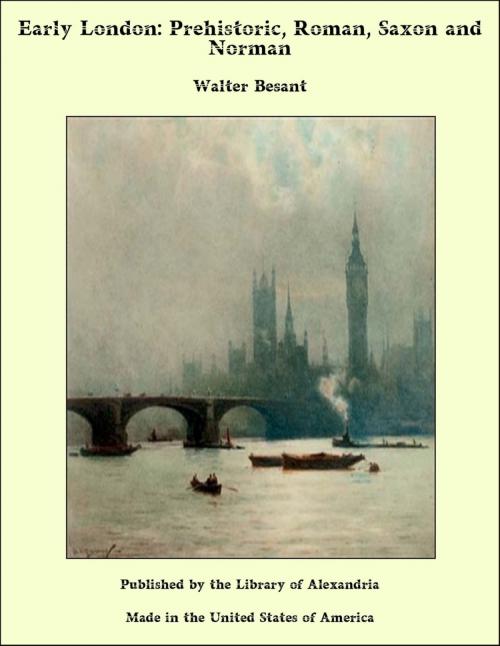Early London: Prehistoric, Roman, Saxon and Norman
Nonfiction, Religion & Spirituality, New Age, History, Fiction & Literature| Author: | Walter Besant | ISBN: | 9781465619358 |
| Publisher: | Library of Alexandria | Publication: | March 8, 2015 |
| Imprint: | Language: | English |
| Author: | Walter Besant |
| ISBN: | 9781465619358 |
| Publisher: | Library of Alexandria |
| Publication: | March 8, 2015 |
| Imprint: | |
| Language: | English |
The buildings of a town often succeed in masking the minor physical features of its site—irregularities are levelled, brooks are hidden beneath arches and find ignominious ends in sewers; canals, quays, and terrace walls may be wholly artificial. To realise completely the original contours of the ground is often a laborious process, demanding inductive reasoning on the evidence obtained in sinking wells, in digging the foundations of the larger buildings, or in making cuttings and tunnels. Still the broader and bolder features cannot be obscured, however thick the encrusting layer of masonry may be. What, then, are these in the case of Greater London? Its site is a broad valley, along the bed of which a tidal river winds in serpentine curves as its channel widens and deepens towards the sea. On either side of this valley the ground slopes upwards, though for a while very gently, towards a hilly district, which rises, sometimes rather steeply, to a height of about 400 feet above sea-level. Towards the north this district passes into an undulating plateau, the chalky uplands of Hertfordshire; on the south it ends in a more sharply defined range, which occasionally reaches an elevation of about 800 feet above the sea—the North Downs. The upland declines a little, the valley broadens towards the sea, as the river changes into an estuary. Between the one and the other there is no very hard and fast division; the ground by the side of each is low, but as a rule by the river it is just high enough to be naturally fit for cultivation, while by the estuary it is a marsh. But as the ground becomes more salubrious, the channel becomes more shallow, and at one place, a short distance above the confluence of a tributary stream from the north—the Lea—this change in the character of the valley is a little more rapid than elsewhere. These conditions seem to have determined the site of the city—the original nucleus of the vast aggregate of houses which forms the London of to-day. Air and water are among the prime requisites of life; no important settlement is likely to be established where the one is insalubrious, the other difficult to obtain. Thus men, in the days before systems of drainage had been devised, would shun the marshes of Essex and Kent, and, in choosing a less malarious site, would seek one where they could get water fit to be drunk, either from brooks which descended from the uplands, or from shallow wells. These conditions, as we shall see, were fulfilled in the site of ancient London; these for long years determined its limits and regulated its expansion.
The buildings of a town often succeed in masking the minor physical features of its site—irregularities are levelled, brooks are hidden beneath arches and find ignominious ends in sewers; canals, quays, and terrace walls may be wholly artificial. To realise completely the original contours of the ground is often a laborious process, demanding inductive reasoning on the evidence obtained in sinking wells, in digging the foundations of the larger buildings, or in making cuttings and tunnels. Still the broader and bolder features cannot be obscured, however thick the encrusting layer of masonry may be. What, then, are these in the case of Greater London? Its site is a broad valley, along the bed of which a tidal river winds in serpentine curves as its channel widens and deepens towards the sea. On either side of this valley the ground slopes upwards, though for a while very gently, towards a hilly district, which rises, sometimes rather steeply, to a height of about 400 feet above sea-level. Towards the north this district passes into an undulating plateau, the chalky uplands of Hertfordshire; on the south it ends in a more sharply defined range, which occasionally reaches an elevation of about 800 feet above the sea—the North Downs. The upland declines a little, the valley broadens towards the sea, as the river changes into an estuary. Between the one and the other there is no very hard and fast division; the ground by the side of each is low, but as a rule by the river it is just high enough to be naturally fit for cultivation, while by the estuary it is a marsh. But as the ground becomes more salubrious, the channel becomes more shallow, and at one place, a short distance above the confluence of a tributary stream from the north—the Lea—this change in the character of the valley is a little more rapid than elsewhere. These conditions seem to have determined the site of the city—the original nucleus of the vast aggregate of houses which forms the London of to-day. Air and water are among the prime requisites of life; no important settlement is likely to be established where the one is insalubrious, the other difficult to obtain. Thus men, in the days before systems of drainage had been devised, would shun the marshes of Essex and Kent, and, in choosing a less malarious site, would seek one where they could get water fit to be drunk, either from brooks which descended from the uplands, or from shallow wells. These conditions, as we shall see, were fulfilled in the site of ancient London; these for long years determined its limits and regulated its expansion.















